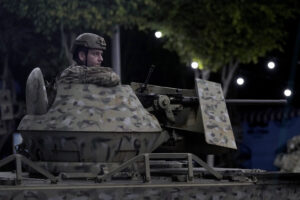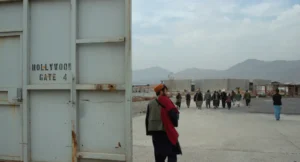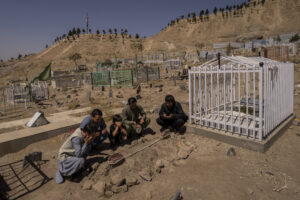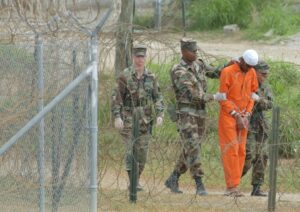The Crucifixion of Tomas Young
Truthdig's Chris Hedges interviews the Iraq War veteran who penned "The Last Letter."
KANSAS CITY, Mo. — I flew to Kansas City last week to see Tomas Young. Young (pictured above) was paralyzed in Iraq in 2004. He is now receiving hospice care at his home. I knew him by reputation and the movie documentary “Body of War.” He was one of the first veterans to publicly oppose the war in Iraq. He fought as long and as hard as he could against the war that crippled him, until his physical deterioration caught up with him.
“I had been toying with the idea of suicide for a long time because I had become helpless,” he told me in his small house on the Kansas City outskirts where he intends to die. “I couldn’t dress myself. People have to help me with the most rudimentary of things. I decided I did not want to go through life like that anymore. The pain, the frustration. …”
He stopped abruptly and called his wife. “Claudia, can I get some water?” She opened a bottle of water, took a swig so it would not spill when he sipped and handed it to him.
“I felt at the end of my rope,” the 33-year-old Army veteran went on. “I made the decision to go on hospice care, to stop feeding and fade away. This way, instead of committing the conventional suicide and I am out of the picture, people have a way to stop by or call and say their goodbyes. I felt this was a fairer way to treat people than to just go out with a note. After the anoxic brain injury in 2008 [a complication that Young suffered] I lost a lot of dexterity and strength in my upper body. So I wouldn’t be able to shoot myself or even open the pill bottle to give myself an overdose. The only way I could think of doing it was to have Claudia open the pill bottle for me, but I didn’t want her implicated.”
| To read Tomas Young’s Last Letter, click here. |
“After you made that decision how did you feel?” I asked.
“I felt relieved,” he answered. “I finally saw an end to this four-and-a-half-year fight. If I were in the same condition I was in during the filming of ‘Body of War,’ in a manual chair, able to feed and dress myself and transfer from my bed to the wheelchair, you and I would not be having this discussion. I can’t even watch the movie anymore because it makes me sad to see how I was, compared to how I am. … Viewing the deterioration, I decided it was best to go out now rather than regress more.”
Young will die for our sins. He will die for a war that should never have been fought. He will die for the lies of politicians. He will die for war profiteers. He will die for the careers of generals. He will die for a cheerleader press. He will die for a complacent public that made war possible. He bore all this upon his body. He was crucified. And there are hundreds of thousands of other crucified bodies like his in Baghdad and Kandahar and Peshawar and Walter Reed medical center. Mangled bodies and corpses, broken dreams, unending grief, betrayal, corporate profit, these are the true products of war. Tomas Young is the face of war they do not want you to see.
On April 4, 2004, Young was crammed into the back of a two-and-a-half-ton Army truck with 20 other soldiers in Sadr City, Iraq. Insurgents opened fire on the truck from above. “It was like shooting ducks in a barrel,” he said. A bullet from an AK-47 severed his spinal column. A second bullet shattered his knee. At first he did not know he had been shot. He felt woozy. He tried to pick up his M16. He couldn’t lift his rifle from the truck bed. That was when he knew something was terribly wrong.
“I tried to say ‘I’m going to be paralyzed, someone shoot me right now,’ but there was only a hoarse whisper that came out because my lungs had collapsed,” he said. “I knew the damage. I wanted to be taken out of my misery.”
His squad leader, Staff Sgt. Robert Miltenberger, bent over and told him he would be all right. A few years later Young would see a clip of Miltenberger weeping as he recounted the story of how he had lied to Young.
“I tried to contact him,” said Young, whose long red hair and flowing beard make him look like a biblical prophet. “I can’t find him. I want to tell him it is OK.”
Young had been in Iraq five days. It was his first deployment. After being wounded he was sent to an Army hospital in Kuwait, and although his legs, now useless, lay straight in front of him he felt as if he was still sitting cross-legged on the floor of the truck. That sensation lasted for about three weeks. It was an odd and painful initiation into his life as a paraplegic. His body, from then on, would play tricks on him. He was transferred from Kuwait to the U.S. military hospital at Landstuhl, Germany, and then to Walter Reed, in Washington, D.C. He asked if he could meet Ralph Nader, and Nader visited him in the hospital with Phil Donahue. Donahue, who had been fired by MSNBC a year earlier for speaking out against the war, would go on, with Ellen Spiro, to make the 2007 film “Body of War,” a brutally honest account of Young’s daily struggle with his physical and emotional scars of war. In the documentary, he suffers dizzy spells that force him to lower his head into his hands. He wears frozen gel inserts in a cooling jacket because he cannot control his body temperature. He struggles to find a solution to his erectile dysfunction. He downs fistfuls of medications — carbamazepine, for nerve pain; coumadin, a blood thinner; tizanidine, an anti-spasm medication; gabapentin, another nerve pain medication, bupropion, an antidepressant; omeprazole, for morning nausea; and morphine. His mother has to insert a catheter into his penis. He joins Cindy Sheehan at Camp Casey in Crawford, Texas, to protest with Iraq Veterans Against the War. His first wife leaves him.
“You know, you see a guy who’s paralyzed and in a wheelchair and you think he’s just in a wheelchair,” he says in “Body of War.” “You don’t think about the, you know, the stuff inside that’s paralyzed. I can’t cough because my stomach muscles are paralyzed, so I can’t work up the full coughing energy. I’m more susceptible to urinary tract infections, and there’s a great big erection sidebar to this whole story.”
In early March 2008 a blood clot in his right arm — the arm that bears a color tattoo of a character from Maurice Sendak’s “Where the Wild Things Are” — caused his arm to swell. He was taken to the Kansas City Veterans Affairs hospital, where he was given the blood thinner coumadin before being released. One month later, the VA took him off coumadin and soon afterward the clot migrated to one of his lungs. He suffered a massive pulmonary embolism and fell into a coma. When he awoke from the coma in the hospital he could barely speak. He had lost most of his upper-body mobility and short-term memory, and his speech was slurred significantly.
It was then that he began to experience debilitating pain in his abdomen. The hospital would not give him narcotics because such drugs slow digestion, making it harder for the bowels to function. Young could digest only soup and Jell-O. In November, in a desperate bid to halt the pain, he had his colon removed. He was fitted with a colostomy bag. The pain disappeared for a few days and then came roaring back. He could not hold down food, even pureed food, because his stomach opening had shrunk. The doctors dilated his stomach. He could eat only soup and oatmeal. Three weeks ago he had his stomach stretched again. And that was enough.
“I will go off the feeding [tube] after me and my wife’s anniversary,” April 20, the date on which he married Claudia in 2012. “I was married once before. It didn’t end well. It was a non-amicable divorce. At first I thought I would [just] wait for my brother and his wife, my niece and my grandparents to visit me, but the one thing I will miss most in my life is my wife. I want to spend a little more time with her. I want to spend a full year with someone without the problems that plagued my previous [marriage]. I don’t know how long it will take when I stop eating. If it takes too long I may take steps to quicken my departure. I have saved a bottle of liquid morphine. I can down that at one time with all my sleeping medication.”
Young’s room is painted a midnight blue and has a large cutout of Batman on one wall. He loved the superhero as a child because “he was a regular person who had a horrible thing happen to him and wanted to save society.”
Young joined the Army immediately after 9/11 to go to Afghanistan and hunt down the people behind the attacks. He did not oppose the Afghanistan war. “In fact, if I had been injured in Afghanistan, there would be no ‘Body of War’ movie to begin with,” he said. But he never understood the call to invade Iraq. “When the Japanese attacked Pearl Harbor we didn’t invade China just because they looked the same,” he said.
He became increasingly depressed about his impending deployment to Iraq when he was in basic training at Fort Benning, Ga. He asked the battalion doctor for antidepressants. The doctor said he had to meet first with the unit’s chaplain, who told him, “I think you will be happier when you get over to Iraq and start killing Iraqis.”
“I was dumbstruck by his response,” Young said.
He has not decided what will be done with his ashes. He flirted with the idea of having them plowed into ground where marijuana would be planted but then wondered if anyone would want to smoke the crop. He knows there will be no clergy at the memorial service held after his death. “It will just be people reminiscing over my life,” he said.
“I spend a lot of time sitting here in my bedroom, watching TV or sleeping,” he said. “I have found — I don’t know if it is the result of my decision or not — [it is] equally hard to be alone or to be around people. This includes my wife. I am rarely happy. Maybe it is because when I am alone all I have with me are my thoughts, and my mind is a very hazardous place to go. When I am around people I feel as if I have to put on a facade of being the happy little soldier.” He listens, when he is well enough, to audiobooks with Claudia. Among them have been Al Franken’s satirical book “Lies and the Lying Liars Who Tell Them” and Michael Moore’s “The Official Fahrenheit 9/11 Reader.” He was a voracious reader but can no longer turn the pages of a book. He finds some solace in the French film “The Intouchables,” about a paraplegic and his caregiver, and “The Sessions,” a film based on an essay by the paralyzed poet Mark O’Brien.
Young, when he was in a wheelchair, found that many people behaved as if he was mentally disabled, or not even there. When he was being fitted for a tuxedo for a friend’s wedding the salesman turned to his mother and asked her in front of him whether he could wear the company’s shoes.
“I look at the TV through the lens of his eyes and can see he is invisible,” said Claudia, standing in the living room as her husband rested in the bedroom. An array of books on death, the afterlife and dying are spread out around her. “No one is sick [on television]. No one is disabled. No one faces death. Dying in America is a very lonely business.”
“If I had known then what I know now,” Young said, “I would not have gone into the military. But I was 22, working various menial jobs, waiting tables, [working] in the copy department of an OfficeMax. My life was going nowhere. Sept. 11 happened. I saw us being attacked. I wanted to respond. I signed up two days later. I wanted to be a combat journalist. I thought the military would help me out of my financial rut. I thought I could use the GI Bill to go to school.”
Young is not the first young man to be lured into war by the false sirens of glory and honor and then callously discarded by the war makers. His story has been told many times. It is the story of Hector in “The Iliad.” It is the story of Joe Bonham, the protagonist in Dalton Trumbo’s 1939 novel “Johnny Got His Gun,” whose arms, legs and face are blown away by an artillery shell, leaving him trapped in the inert remains of his body.
Bonham ruminates in the novel: “Inside me I’m screaming, nobody pays any attention. If I had arms, I could kill myself. If I had legs, I could run away. If I had a voice, I could talk and be some kind of company for myself. I could yell for help, but nobody would help me.”
For Young, the war, the wound, the paralysis, the wheelchair, the anti-war demonstrations, the wife who left him and the one who didn’t, the embolism, the loss of motor control, the slurred speech, the colostomy, the IV line for narcotics implanted in his chest, the open bed sores that expose his bones, the despair — the crushing despair — the decision to die, have come down to a girl. Aleksus, his only niece. She will not remember her uncle. But he lies in his dimly lit room, painkillers flowing into his broken body, and he thinks of her. He does not know exactly when he will die. But it must be before her second birthday, in June. He will not mar that day with his death.
And though he is an atheist, though he believes that there is nothing after death — that, as he says, “the body is like a toy that runs out of batteries, only there are no replacements” — his final act honors the promise of Aleksus’ life. As he spoke to me softly of this child — it hurts, even now, he said, to know she will grow up without him — I wondered, sitting next to him on his bed, if he saw it, the glory of it, his final bow not before the specter of his death but the sanctity of her life. The resurrection.
To read Tomas Young’s “Last Letter,” click here.
Your support matters…Independent journalism is under threat and overshadowed by heavily funded mainstream media.
You can help level the playing field. Become a member.
Your tax-deductible contribution keeps us digging beneath the headlines to give you thought-provoking, investigative reporting and analysis that unearths what's really happening- without compromise.
Give today to support our courageous, independent journalists.








You need to be a supporter to comment.
There are currently no responses to this article.
Be the first to respond.